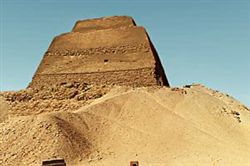
On the west bank of the Nile, opposite Atfih (Aphroditopolis) and close to the necropolis of the Faiyum. Maidum is dominated by a pyramid built either by Huni or his son Seneferu. It is usually assumed that Huni was the builder, although there is also reason to believe that this king was buried at Saqqara. Moreover, his name does not appear anywhere in the monument. On the other hand, the name of Seneferu is mentioned, but only in graffiti dating to the New Kingdom, that is, more than a thousand years later. It is uncertain whether the Egyptians then still knew for whom the pyramid had been built. Moreover, Seneferu is known to have built two further pyramids at Dahshour. Perhaps Seneferu completed a monument begun by his predecessor. The pyramid was originally begun as a building with seven steps; later this was increased by an eighth step and the whole was then given flat sides by filling in the steps, making this the first 'true' pyramid. In later times, possibly as late as the New Kingdom, this facing collapsed, leaving the pyramid in its present shape - a wide, stubby tower. Around the pyramid are a large number of mastabas, many once beautifully decorated. In one (mastaba 17) archaeologists found a wooden hammer used by tomb robbers thousands of years ago still in position propping up the lid of the granite sarcophagus. The statues of Rahotep and Nofret and the famous depiction of the Maidum geese (now all in the Egyptian Museum in Cairo) were found close by. In antiquity a place called Meri-Item (=beloved of Atum) lay nearby, where presumably this god was worshipped. The Egyptian name, probably pronounced Ma-itum, is preserved in the modern name. It is also known that during part of the New Kingdom lands belonging to Aten were located here.